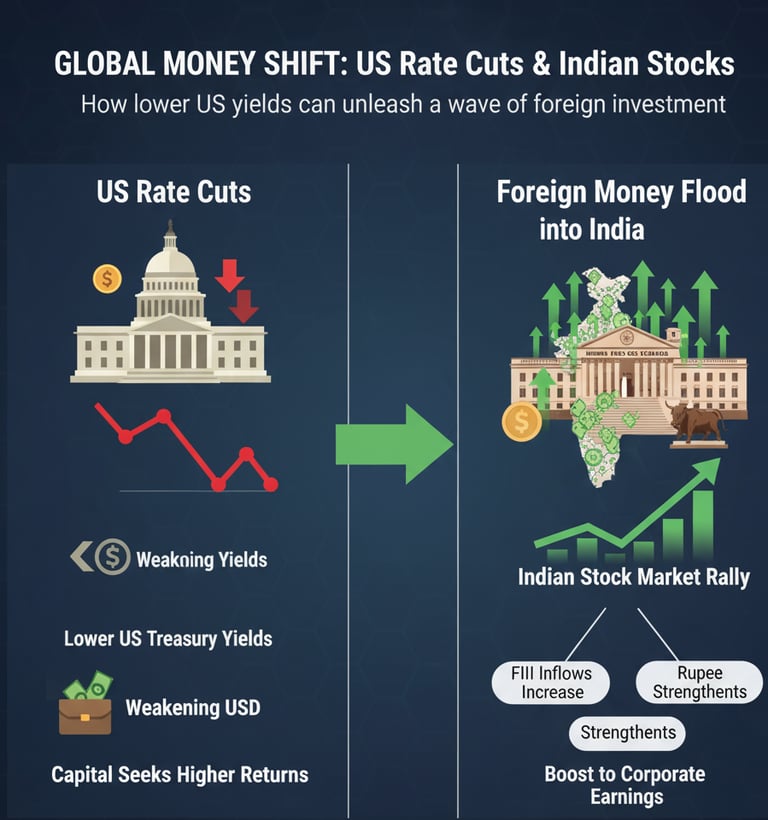Will US Rate Cuts Unleash a Foreign Money Flood into Indian Stocks?
With the Fed poised to cut rates, will FIIs finally return to Indian equities? We break down the relationship between US rates, the dollar, and foreign investment in India.
RAVINDRA PRAJAPATI (EDUCATIONAL BLOG)
9/22/20253 min read
The Bull Case: Why a Flood is Likely
The argument for a strong FII comeback is compelling:
The Liquidity Tide: Fed rate cuts are essentially turning on the taps of global liquidity. History shows that periods of easy US monetary policy have strongly correlated with massive FII inflows into India.
India's Standout Growth: While the US might be worrying about a recession, India remains one of the fastest-growing major economies in the world. This growth premium is incredibly attractive to foreign investors seeking earnings growth that is hard to find in developed markets.
Relative Valuation Adjustments: While Indian markets are not cheap, a surge in global liquidity can make valuations appear more reasonable as investors are willing to pay a premium for high growth in a low-yield world.
The Narrative Shift: The mere expectation of rate cuts can be enough to shift market sentiment. We may see inflows begin in anticipation of the first cut, not just after it happens.
The Caveats: Why It Might Not Be a Deluge(Flood)
However, it's crucial to understand the factors that could temper the inflow:
"Higher for Longer" Lite: The Fed may cut rates, but they are unlikely to return to the zero-interest-rate world of the 2010s. Rates might settle at a moderately high level (e.g., 3-4%), which could still make US assets somewhat attractive compared to previous cycles.
Indian Valuations: This is the biggest hurdle. The Indian market is trading at premium valuations compared to its own history and most other emerging markets. FIIs will be selective. They may not blindly buy everything but rather focus on sectors and companies where the growth story justifies the high price.
Global Geopolitical Risks: Factors like US-China tensions, the ongoing war in Ukraine, and global oil price shocks can create risk aversion that overshadows the positive impact of rate cuts.
A Slowing Global Economy: If US rate cuts are in response to a significant economic slowdown or recession, it could hurt global corporate earnings, including those of Indian exporters, dampening investor enthusiasm.
Sectors to Watch: Where Will the Money Flow?
If FIIs return, they are likely to focus on:
Large-Caps & Banking: FIIs often prefer the liquidity and stability of large-cap stocks. Banks are a classic play on Indian economic growth and would benefit from a stable currency.
Capital Goods and Infrastructure: A direct bet on the Indian government's massive capex push.
IT Services (A Contrarian Play): A weakening USD is a headwind for IT earnings (as they bill in dollars). However, if rate cuts are accompanied by a soft landing in the US (no recession), it could lead to increased tech spending by US clients, boosting the sector's outlook.
The Verdict: A Strong Stream, If Not a Flood
So, will US rate cuts bring a flood of foreign money?
A resounding yes, but with conditions.
The shift in the US monetary policy cycle is a definitive green light for global funds to increase their allocation to emerging markets. India, with its stellar growth narrative and political stability, is poised to be a primary beneficiary.
We are likely to see sustained FII inflows, reversing the trend of the last two years. However, the era of ultra-cheap money is over. The inflows will likely be more measured and discerning than in the past, focused on quality and growth justification rather than a broad-based rally.
Key tags:
#FII,#FPI, #USFederalReserve, #RateCuts, #IndianStockMarket, #Nifty50, #Sensex, #GlobalLiquidity, #EmergingMarkets, #USDINR, #CarryTrade, #IndianEconomy, #Investing, #PipiFinTech


For the past two years, Indian equity markets have witnessed a puzzling divergence. While domestic investors (DIIs and retail) have been relentless buyers, foreign institutional investors (FIIs) have often been net sellers or hesitant participants. A primary reason for this FII caution has been the aggressive interest rate hike cycle by the US Federal Reserve.
But now, with inflation cooling, the conversation has decisively shifted from "how high?" to "when and how fast?" rates will be cut.
This begs the billion-dollar question: Will US rate cuts finally open the floodgates for foreign money to rush back into Indian equities?
The answer is nuanced, but the conditions are certainly setting up for a strong tailwind. Let's break it down.
The Simple Logic: Why US Rates Matter to Indian Markets
The connection isn't direct, but it's powerful, flowing through a concept called global liquidity and carry trades.
The "Risk-On" vs. "Risk-Off" Dynamic:
High US Rates: When US interest rates are high and rising, US Treasury bonds become a safe and attractive investment offering solid returns. This pulls global capital away from "riskier" emerging markets like India and back to the safety of the US. This is a "risk-off" environment.
Cutting US Rates: When the Fed cuts rates, the yield on US Treasuries falls. This makes them less attractive, pushing global investors to search for higher returns elsewhere. This search for yield (or "risk-on" mood) benefits riskier assets, with Indian equities being a prime destination.
The Dollar and Carry Trades:
Lower US interest rates typically weaken the US dollar (USD).
A weaker USD is a massive tailwind for emerging markets. It makes their assets cheaper for foreign investors to buy and reduces the debt burden for companies that have borrowed in dollars.
It also revitalizes the "carry trade," where investors borrow money in a low-interest-rate currency (like the future USD) and invest it in a higher-yielding one (investing in Indian stocks). Rate cuts make this trade more profitable.
RAVINDRA PRAJAPATI, Not a sebi registered
FOLLOW Us
ravindra.prajapati1122@gmail.com
+91 9795187745
© 2025. PiPiFinTech All rights reserved.
Contact Us
ABOUT Us
Our mission is to empower you to maximize every single penny and best solution for wealth generation and management for every mature age group.
Product TOPICS
Digital E-Wealth Platform
Mutual Funds
Education Planning
Insurance
FD and Bonds
Retirement Planning
Wealth Creation
(Disclaimers : Mutual Fund investments are subject to market risks, please read scheme related documents carefully.)
